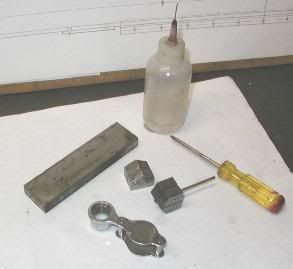Oldmechthings
Well-Known Member
- Joined
- Jan 10, 2008
- Messages
- 153
- Reaction score
- 12
A couple days ago there was discussion on the forum about sharpening small drills. I learned how to sharpen drills in High School, and have had a lot of practice since then, and I can do a pretty good job until they get down to about 3/23" and smaller, then I have a difficult time keeping the cutting lips the same length. So for the small drills I use sharpening guides, and sharpen the drills on a hand stone.

Shown here is the equipment that I use. The drills are clamped in the guides, protruding slightly, and oriented so they will get the right clearance, (that is where the magnifier comes into play) and then sharpened on the stone. Pretty simple. I regularly sharpen drills down to about .020" diameter. I could go smaller, but I have not yet used drills smaller than that.
In the book "Two Shop Masters" published by Village Press, Frank McLean has a section on building and using sharpening guides. He stated that "All the old machinists had them", who ever they were.

Shown here is the equipment that I use. The drills are clamped in the guides, protruding slightly, and oriented so they will get the right clearance, (that is where the magnifier comes into play) and then sharpened on the stone. Pretty simple. I regularly sharpen drills down to about .020" diameter. I could go smaller, but I have not yet used drills smaller than that.
In the book "Two Shop Masters" published by Village Press, Frank McLean has a section on building and using sharpening guides. He stated that "All the old machinists had them", who ever they were.




